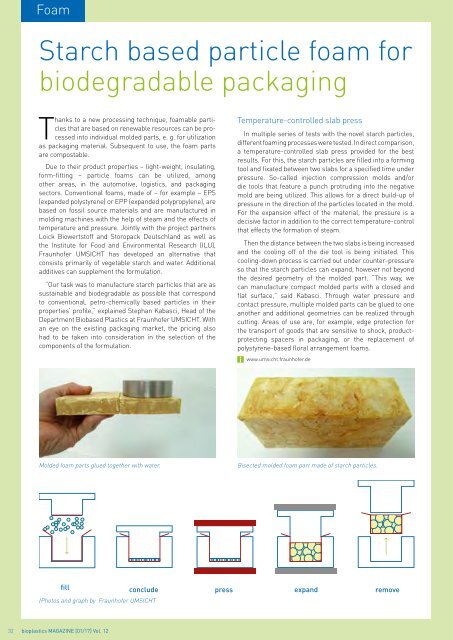Issue 01/2017
bioplasticsMAGAZINE_1701
bioplasticsMAGAZINE_1701
You also want an ePaper? Increase the reach of your titles
YUMPU automatically turns print PDFs into web optimized ePapers that Google loves.
Foam<br />
Starch based particle foam for<br />
biodegradable packaging<br />
Thanks to a new processing technique, foamable particles<br />
that are based on renewable resources can be processed<br />
into individual molded parts, e. g. for utilization<br />
as packaging material. Subsequent to use, the foam parts<br />
are compostable.<br />
Due to their product properties – light-weight, insulating,<br />
form-fitting – particle foams can be utilized, among<br />
other areas, in the automotive, logistics, and packaging<br />
sectors. Conventional foams, made of – for example – EPS<br />
(expanded polystyrene) or EPP (expanded polypropylene), are<br />
based on fossil source materials and are manufactured in<br />
molding machines with the help of steam and the effects of<br />
temperature and pressure. Jointly with the project partners<br />
Loick Biowertstoff and Storopack Deutschland as well as<br />
the Institute for Food and Environmental Research (ILU),<br />
Fraunhofer UMSICHT has developed an alternative that<br />
consists primarily of vegetable starch and water. Additional<br />
additives can supplement the formulation.<br />
“Our task was to manufacture starch particles that are as<br />
sustainable and biodegradable as possible that correspond<br />
to conventional, petro-chemically based particles in their<br />
properties’ profile,” explained Stephan Kabasci, Head of the<br />
Department Biobased Plastics at Fraunhofer UMSICHT. With<br />
an eye on the existing packaging market, the pricing also<br />
had to be taken into consideration in the selection of the<br />
components of the formulation.<br />
Temperature-controlled slab press<br />
In multiple series of tests with the novel starch particles,<br />
different foaming processes were tested. In direct comparison,<br />
a temperature-controlled slab press provided for the best<br />
results. For this, the starch particles are filled into a forming<br />
tool and fixated between two slabs for a specified time under<br />
pressure. So-called injection compression molds and/or<br />
die tools that feature a punch protruding into the negative<br />
mold are being utilized. This allows for a direct build-up of<br />
pressure in the direction of the particles located in the mold.<br />
For the expansion effect of the material, the pressure is a<br />
decisive factor in addition to the correct temperature-control<br />
that effects the formation of steam.<br />
Then the distance between the two slabs is being increased<br />
and the cooling off of the die tool is being initiated. This<br />
cooling-down process is carried out under counter-pressure<br />
so that the starch particles can expand, however not beyond<br />
the desired geometry of the molded part. “This way, we<br />
can manufacture compact molded parts with a closed and<br />
flat surface,” said Kabasci. Through water pressure and<br />
contact pressure, multiple molded parts can be glued to one<br />
another and additional geometries can be realized through<br />
cutting. Areas of use are, for example, edge protection for<br />
the transport of goods that are sensitive to shock, productprotecting<br />
spacers in packaging, or the replacement of<br />
polystyrene-based floral arrangement foams.<br />
www.umsicht.fraunhofer.de<br />
Molded foam parts glued together with water.<br />
Bisected molded foam part made of starch particles.<br />
fill conclude press expand remove<br />
(Photos and graph by Fraunhofer UMSICHT<br />
32 bioplastics MAGAZINE [<strong>01</strong>/17] Vol. 12


















